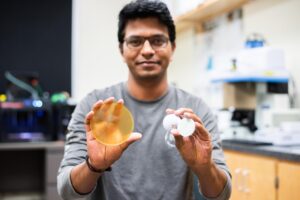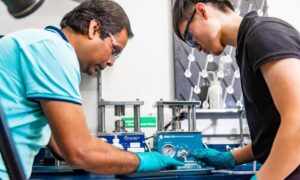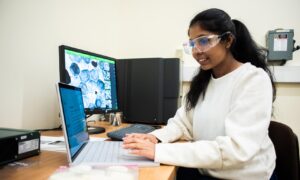Isabella Earp is a typical teen: she works at McDonald’s and enjoys the usual summertime activities. But, like Clark Kent stepping into a phone booth to trade his plain clothes for a Superman cloak, Earp came to Pitt State two days a week this summer to work with scientists. Their quest: to find clean and renewable energy sources that could have a dramatic impact on the world’s carbon emissions.
She is so driven by the opportunity, in fact, that she’s willing to drive the four-hour round trip from Overland Park, where she attends school at St. Thomas Aquinas, to the Kansas Polymer Research Center at Pittsburg State University.
“I’m in an environmental club in high school and am excited about anything STEM and the ability to continue learning that here,” she said. “Renewable energy is a big topic and doing this kind of work will give me the edge.”
It’s also giving her $8 an hour, 20 hours a week, in a more intriguing job, she noted, than her job serving French fries.
She’s not alone. Seven other high school students are part of the internship program, funded by grants through the Polymer Chemistry program at Pittsburg State, as well as NASA Kansas Space Grant and the National Institute of Standards and Technology.
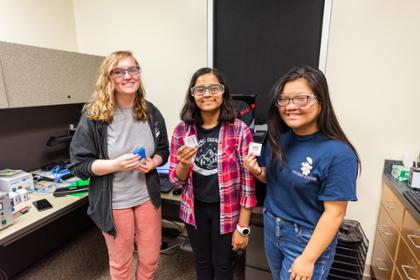
“It’s worth it”
Parker Neely, a senior at Columbus (Kansas) High School, didn’t think twice about making the one-hour round trip drive.
“I love chemistry, I love physics, and Pitt State has one of the best polymer chemistry programs in the nation,” he said. “It’s worth it.”
Earp and Neely, along with Ashlan Brooks, Anjali Gupta, Madeline Ellis, and Cassia Allison of Pittsburg High School, and Kamilla Frevele, a senior at Southeast High School in Cherokee, Kansas, are synthesizing a new material, printed by 3D printers, to be used in super capacitors, batteries, and fuel cells. They’re joined by Peyton Klamar, an undergraduate student at Pittsburg State, and Edilawit Mehari, an undergraduate student at Cottey College.
In plain language, what they’re working on will “produce clean energy,” Anjali explained, “and it will be more efficient and less costly.”
The teens are driven by two things: the desire to gain experience before the next step of their academic journey — experience that will look great on their resumé — and the desire to do something about the environment.
“It feels like I’m doing something valuable to help fix things,” Neely said.
“I want to make a difference,” said Allison. “Our generation knows we have to.”
“It makes me feel important to do something that could make a change in our environment,” said Anjali.
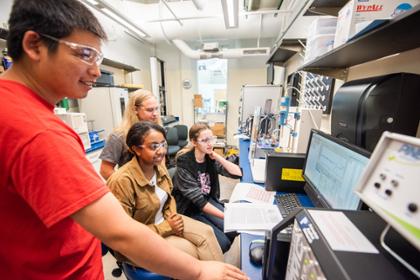
In the lab
The students are conducting their research in Lab 118 and Lab 121 in the heart of the KPRC, located at the east edge of campus next to the university’s softball and baseball fields in a building that flies under the radar.
They’re guided by scientists who have come to Pittsburg from around the world to work in the center. Here, those scientists collaborate with industrial partners, organizations, state and federal agencies, and producer associations to develop and commercialize intellectual property. Their primary focuses: polyurethanes, bio-based materials, polymer foams, and electroactive materials.
The labs give students access to cutting edge equipment like a scanning electron microscope, X-ray diffraction, infrared spectrometer, thermal analyzer, and equipment used for synthesis and electrochemical testing.
“It’s exciting to be a part of it”
As they work, they’re inspired by stories of what students already have helped discover at the KPRC: Last year, two high school students worked with Associate Professor Ram Gupta to find a solution to convert biowaste — things like pomegranate shells, used coffee grounds, and soybean stems, leaves, and shells — into an energy storage device. Other students have helped developed eco-friendly flame retardant foam that can be used in commercial applications such as construction and automobiles.
The fuel cells this year’s students are researching could be used in electric cars.
“Reducing the cost would make them affordable to the masses, while improving their charge would make them more travel friendly,” Gupta said.
The skills the students are learning also have a direct application to the workforce in Kansas, where nearly half a million people are employed in plastics and polymer industries. Beyond Kansas, the sky’s the limit, Gupta said, when it comes to these students finding lucrative jobs in the field — what they’re doing is the future.
“It’s pretty amazing what’s happening here. It’s exciting to be part of it.” — Madeline Ellis

